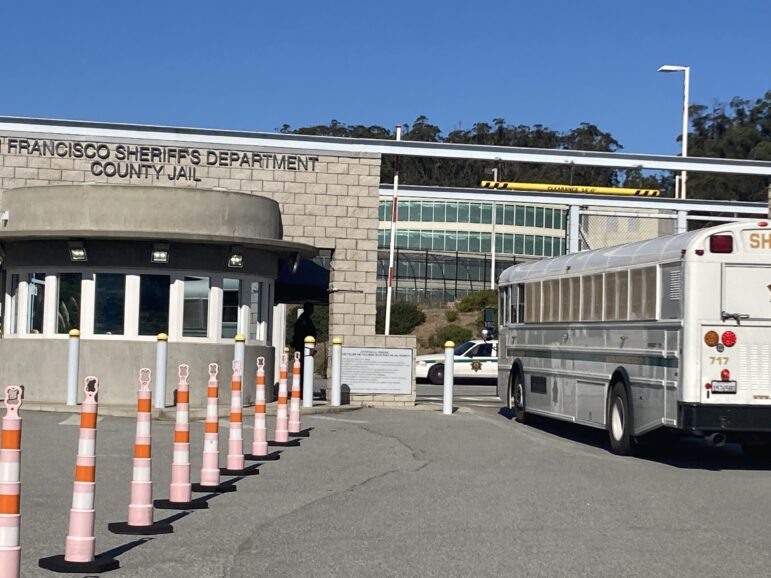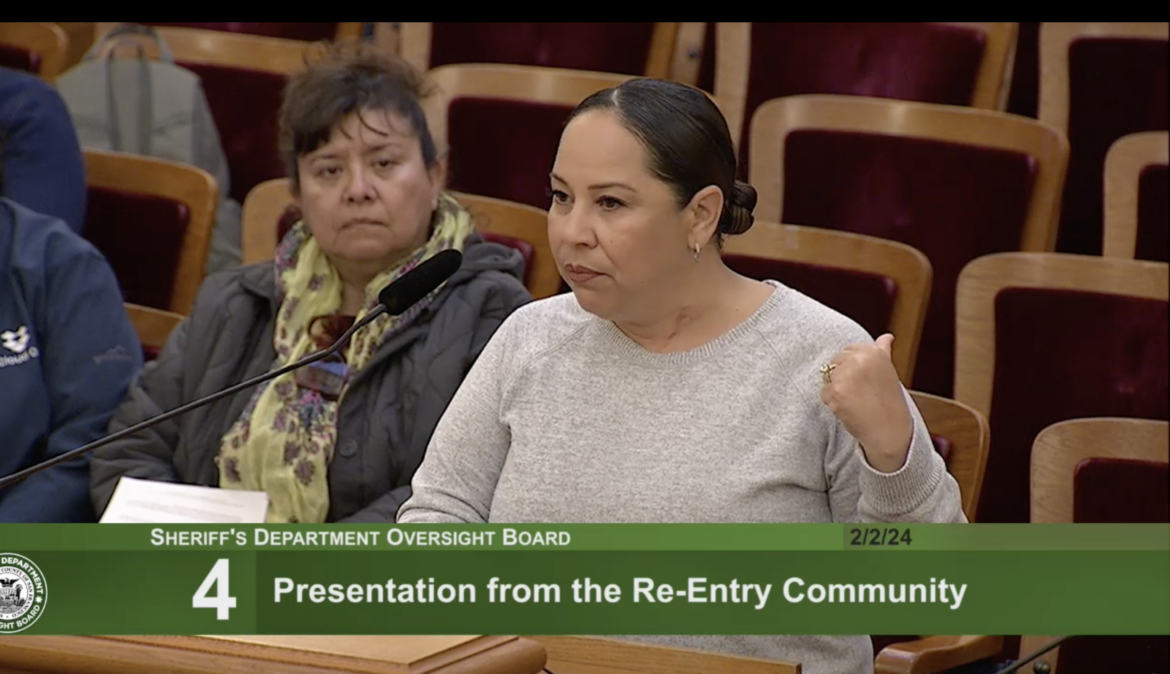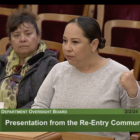Lee esta historia en español.
Some people recite a prayer of gratitude for the time they spent in San Francisco County Jail. Among them is a Bay Area resident we’ll call Carlos to respect his request for anonymity.
“Thank God,” said Carlos, 29. “I sought a better life because I got close to good people who guided me. I got close to people who really wanted to see me succeed in life.”
Those people were Spanish-language county jail reentry program providers. Carlos came to San Francisco from Honduras, pursuing promised work that never materialized. Instead, he sold drugs.
That all changed nearly four years ago when he was booked into San Francisco County Jail on drug violations. Once incarcerated, he met Spanish-speaking staff from the ReSET Justice Collaborative — one of myriad community organizations that work with the jail’s program director to provide vocational training, educational courses, substance use disorder treatment, anger management counseling, cultural activities, English classes and religious observances.
“They went to visit me in jail, and from there they signed me up to the places where they could help me,” Carlos said. “Because of how much they taught me, after I left, they helped me get a job that I still have. I have been working in this job here for two years. I never went back to being involved with drug dealing again. I have not gone into the Tenderloin again, and it has helped me a lot because it has brought more peace of mind to my family.”
But Spanish-language programming at San Francisco’s County Jail has since become virtually nonexistent as routine lockdowns caused by staff shortages have made it practically impossible to hold classes. Even while deputies work mandatory 16-hour shifts, there aren’t enough of them to escort people who administer rehabilitation sessions and other training programs into the jails. On Feb. 2, numerous social service providers for the Latinx incarcerated population implored the Sheriff’s Department Oversight Board at its monthly meeting to help them gain access to the jail.
It appeared that jail leadership responded to the public call-out the following week by announcing a new Spanish-language substance use recovery program and art therapy class, however a jail spokesperson said the classes had been in the works since last October. Nevertheless, some longtime jail workers expressed doubt that the programs would last for more than a few weeks.
The lack of Spanish-language programming is an increasingly dire problem since Latinx incarcerations have been on the rise since last June’s launch of a police crackdown on drugs in the Tenderloin and South of Market neighborhoods.
According to Sheriff’s Department data, from June 1 to Nov. 10, 2023 (the most recent available), 42% of people booked in San Francisco County Jail on drug-related charges were Latinx compared with 30% who were Black and 28% who were white. And as Carlos witnessed years ago, some people desperately need to communicate their need for help.
“There are people there who have mental problems, mental problems that they cannot deal with, and how are they going to tell that to someone who knows only English and doesn’t understand?” Carlos said.
Last year’s police crackdown also targeted people for simple drug use as a means of encouraging them into substance use disorder treatment, according to city and law enforcement officials. Yet since then the jail’s treatment program, Road to Recovery, has been available only in English, despite an expressed interest in treatment from the Latinx population.
According to city Department of Public Health data, during the 12 months that ended in September 2023, Jail Health Services assessed 380 incarcerated Latinx patients as having an opioid use disorder. Of them, 209 sought treatments through medications such as buprenorphine or methadone.
It’s unclear how many of them lost out on treatment programming because they were monolingual Spanish speakers, since the data don’t track language preference. But in one instance last October, service provider Joanna Hernandez of the Latino Task Force, a San Francisco-based association of more than three dozen community-based organizations, said she witnessed a “pod” — a group of men assigned to a small congregation of cells — attending Road to Recovery at County Jail No. 3 in San Bruno. Hernandez said of the 46 men attending, 20 were Spanish speakers and could barely understand the curriculum.
“Sometimes they just sit and kind of understand some of the words but if not, they’ll just go to their cells,” Hernandez said. “And then I checked in with the staff, and he told me, ‘I don’t have Spanish-speaking staff and it sucks because they keep putting people who don’t speak the language in this program pod.’
“It’s something that happens a lot inside the jails. So, people are coming back to the same mess, back to the same behavior — if not coming back even worse, because they were confined and ripped from their family, their children, their religion, like everything.”
Ali Riker, director of programs for the Sheriff’s Department, said she was aware that Spanish speakers attended the English-language Road to Recovery program. She said she speculated that this happened because they had enough English proficiency to request access.
“We weren’t, like, barring people from participating who requested it,” Riker said. “I know it’s not ideal. We’re doing our best. Is it enough? You know, we need more. We definitely need more resources.”

Sylvie Sturm / San Francisco Public Press
San Francisco County Jail #3 in San Bruno is one of the locations where inmates may attend Road to Recovery substance use disorder rehabilitation classes in English. The program is not currently offered in Spanish.Hernandez joined the other Latinx social service providers at the Sheriff’s Department Oversight Board on Feb. 2. She said she’s experienced the chaos caused by short staffing.
“When you get there to facilitate your class, you’re told, ‘Sorry, we’re not at our minimum, program is cancelled,’” Hernandez said, adding that neglecting jail vocational and rehabilitation opportunities is counterproductive to the city’s stated goals.
“I know that people want public safety,” she said. “And I know that people want drug sales to stop, their cars being robbed or bipped. But what are we doing locking people up and they’re not receiving any rehabilitation?”
Long-term negative effects are especially dismal for incarcerated youth. Latinx people aged 18 to 24 represented 10 times more drug-related bookings in San Francisco jail from June 1 to Nov. 10 than either their Black or white counterparts. And advocates say younger people especially need reentry programs since criminal records inhibit them from gaining work skills, career advancements and economic opportunities.
The community group representatives told the oversight commissioners that they and other program providers are best positioned to help turn these lives around.
“We are culturally competent,” said Bianca Sanchez, a case manager at Bay Area Community Resources. “We implement a healing-centered approach and have a trauma-informed lens, making us more equipped to provide services and support inside the jails. As trained professionals, we can provide the effective intervention, treatment and rehabilitation services to break the cycles of incarceration.”
Julie Soo, president of the oversight board, said the request was in keeping with decades-old city legislation enshrining the right to equal access to city services for all San Franciscans, including those with limited proficiency in English — legislation that she helped draft. But, she said, a “very conservative” Sheriff’s Department budget will require “setting up priorities.”
New Programs Arriving but Doubts Remain
Less than a week after the oversight board meeting, a new Spanish-language version of a substance abuse recovery class called Living in Balance was launched as well as a Spanish-language art therapy class.
Riker said she’s optimistic that class scheduling will remain stable since the Sheriff’s Department has delivered programs uninterrupted from 9 to 11 a.m. in the jail annex — where a large number of Spanish-speaking inmates have recently been transferred — for a few months now.
Others are not as optimistic as Riker. Hernandez said the two hours a day compete with outdoor time, phone calls and lawyer visits, among other activities — and it’s a far cry from the six to seven hours a day of addiction treatment programming that inmates used to get. And a longtime jail worker speaking on condition of anonymity said they believe the new curriculum is just for show.
“They do stuff, you know, for the cameras, and then when it’s over with, when nobody’s looking, it goes back to how it was,” the worker said, adding, “I give it two weeks.”
Sylvie Pagan of NoVA, the No Violence Alliance Program, whose participants return to the community after serving time for a violent offense or multiple arrests, told the oversight board on Feb. 2 that her organization was also launching a Latino program in jail the next week. But, she said, “this is just a seed in a large bucket of many, many needs that we need for community.”
Riker said she’s eager to partner with more community organizations, and with the meager resources at her disposal, she’s imploring outside groups for even more help.
Riker encouraged any community-based organizations focused on providing volunteer services to the newcomer Spanish-speaking population to help by emailing William Cooper, rehabilitation services manager with the Sheriff’s Department, at [email protected].
Mayor’s Budget Prioritizes Police
Last year’s police crackdown on drugs caused the jail population to balloon from 800 people in June to more than 1,100 today. The situation exacerbated an already critical level of staff shortages at the sheriff’s office, which, according to the latest reports, needs to hire 207 people to fully staff its contingent of 920 positions.
Last year, civil rights attorney Yolanda Huang sued San Francisco on behalf of incarcerated people who claimed they suffered serious health problems from lack of sunlight after years of lockdowns. That issue is still being litigated, Huang said.
“The solution is, if the mayor wants to put people in jail — and I’m not talking about whether or not it should or should not happen — then she has to pay for it,” Huang said. “She has to fully staff the jail. And if she’s not going to fully staff the jail, then they need to not put these people in jail. It’s real simple. If you’re going to house them and control them, then you have to do it right. And they’re not.”
And it’s not just jails that are suffering. Gaps in duties normally assigned to sheriff’s deputies led the San Francisco Public Defender’s office to sue San Francisco County Superior Court over trial backlogs, claiming it infringed their clients’ right to a speedy trial. The court said trial delays were due to the sheriff’s office being overextended at the jails and the Hall of Justice.
Nevertheless, Mayor London Breed slashed the sheriff’s budget by $8 million for 2023-24 giving the department an annual total of $292 million. She did, however, increase the San Francisco Police Department’s budget by $61 million for 2023-24 and another $11 million the following fiscal year for a total of $786 million. That funding will go toward hiring 500 more officers, overtime and higher salaries negotiated under a new union contract.
Also, last June, city supervisors endorsed a resolution by Supervisor Matt Dorsey requesting that the city Human Resources Department draft a policy of hiring bonuses for police department recruits that would compete with other law enforcement agencies in Northern California.
On Jan. 16, Breed and Police Chief Bill Scott issued a joint press release touting their successes. The release announced that three police academy classes totaling 60 recruits were scheduled to graduate in February and May. The achievement was thanks to a higher starting pay and streamlined testing and hiring processes, the release stated. There was no mention of hiring bonuses.
Meanwhile, there are reportedly fears at the Sheriff’s Department that signing bonuses at other agencies could entice away even more deputies — like a widely publicized signing bonus of $75,000 from the Alameda Police Department for new recruits or lateral hires from other police departments.
UPDATED 2/14/2024: The story was updated with additional information from a jail spokesperson who said that jail leadership last October began organizing the Spanish-language programming that was recently announced.
Sylvie Sturm reported this story while participating in the USC Annenberg Center for Health Journalism’s 2023 Data Fellowship, which provided training, mentoring and funding to support this project.










